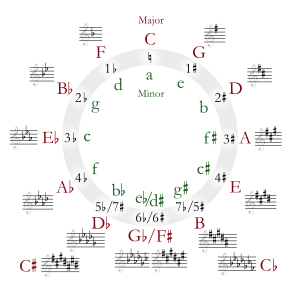C-sharp major facts for kids
 |
||
| Relative key | A♯ minor | |
|---|---|---|
| Parallel key | C♯ minor | |
| Notes in this scale | ||
| C♯, D♯, E♯ (F), F♯, G♯, A♯, B♯ (C), C♯ | ||
C♯ major (also called C-sharp major) is a major scale in music. It starts on the note C-sharp. A scale is like a musical ladder. It has a special sign called a key signature. This key signature has seven sharps.
The notes in the C-sharp major scale are:
- C-sharp
- D-sharp
- E-sharp (which sounds like F)
- F-sharp
- G-sharp
- A-sharp
- B-sharp (which sounds like C)
This scale has a relative minor key. That is A♯ minor. It also has a parallel minor key. This is C♯ minor.
Contents
Understanding C-sharp Major
What is a Key Signature?
A key signature tells musicians which notes to play higher or lower. For C-sharp major, the key signature has seven sharp symbols. These symbols are placed at the start of a piece of music. They mean that every C, D, E, F, G, A, and B note should be played as a sharp.
Enharmonic Equivalent: D-flat Major
C-sharp major has an enharmonic equivalent. This means it sounds the same as another key. Its equivalent is D♭ major. Even though they sound the same, they are written differently. D-flat major uses five flat symbols in its key signature.
C-sharp Major in Instruments
Harp Tuning
When a harp is tuned to C-sharp major, all its pedals are in the bottom position. This makes the strings shorter. When strings are shorter, they are less resonant. This means the sound might not ring out as much.
Famous Music in C-sharp Major
Most composers often choose to use D-flat major instead of C-sharp major. This is because D-flat major has fewer sharps (five flats versus seven sharps). It can be easier to read and play. However, some famous composers did use C-sharp major.
- Johann Sebastian Bach chose C-sharp major. He used it for Prelude and Fugue No. 3. This was in both books of his famous work, The Well-Tempered Clavier.
- Franz Liszt used C-sharp major in his Hungarian Rhapsody No. 6. He changed from D-flat major to C-sharp major near the start of the piece.
- Maurice Ravel used C-sharp major as the main key for Ondine. This piece is from his piano suite Gaspard de la nuit.
- Louis Vierne also used C-sharp major. He used it in the final piece of his Messe solennelle.
| Diatonic Scales and Keys | |||||||||||||||||||||||||||||||||||||||||||||||||||||||
|---|---|---|---|---|---|---|---|---|---|---|---|---|---|---|---|---|---|---|---|---|---|---|---|---|---|---|---|---|---|---|---|---|---|---|---|---|---|---|---|---|---|---|---|---|---|---|---|---|---|---|---|---|---|---|---|
|
|||||||||||||||||||||||||||||||||||||||||||||||||||||||
| The table shows the number of sharps or flats in each scale. Minor scales are written in lower case. | |||||||||||||||||||||||||||||||||||||||||||||||||||||||
See also
 In Spanish: Do sostenido mayor para niños
In Spanish: Do sostenido mayor para niños


